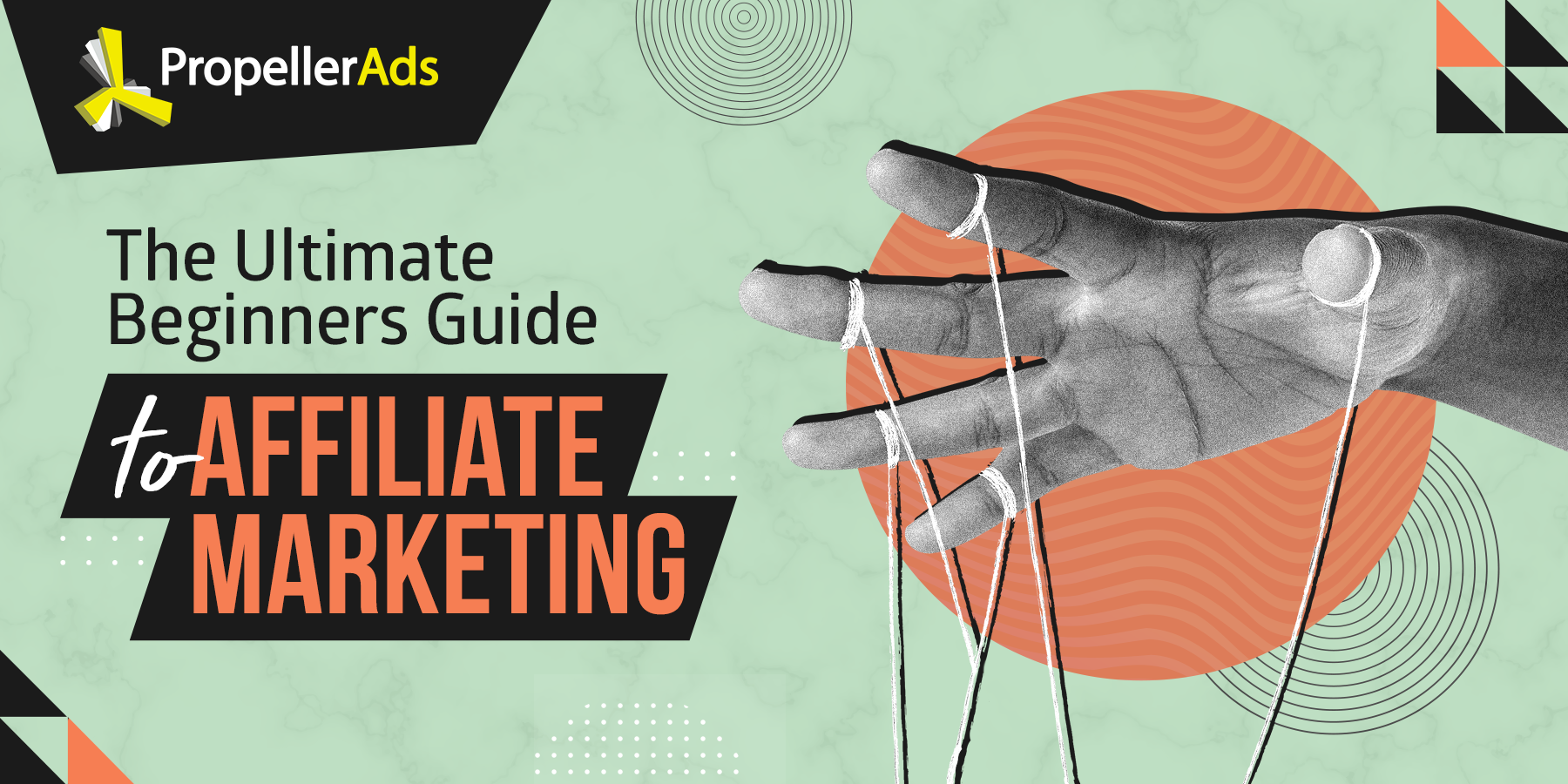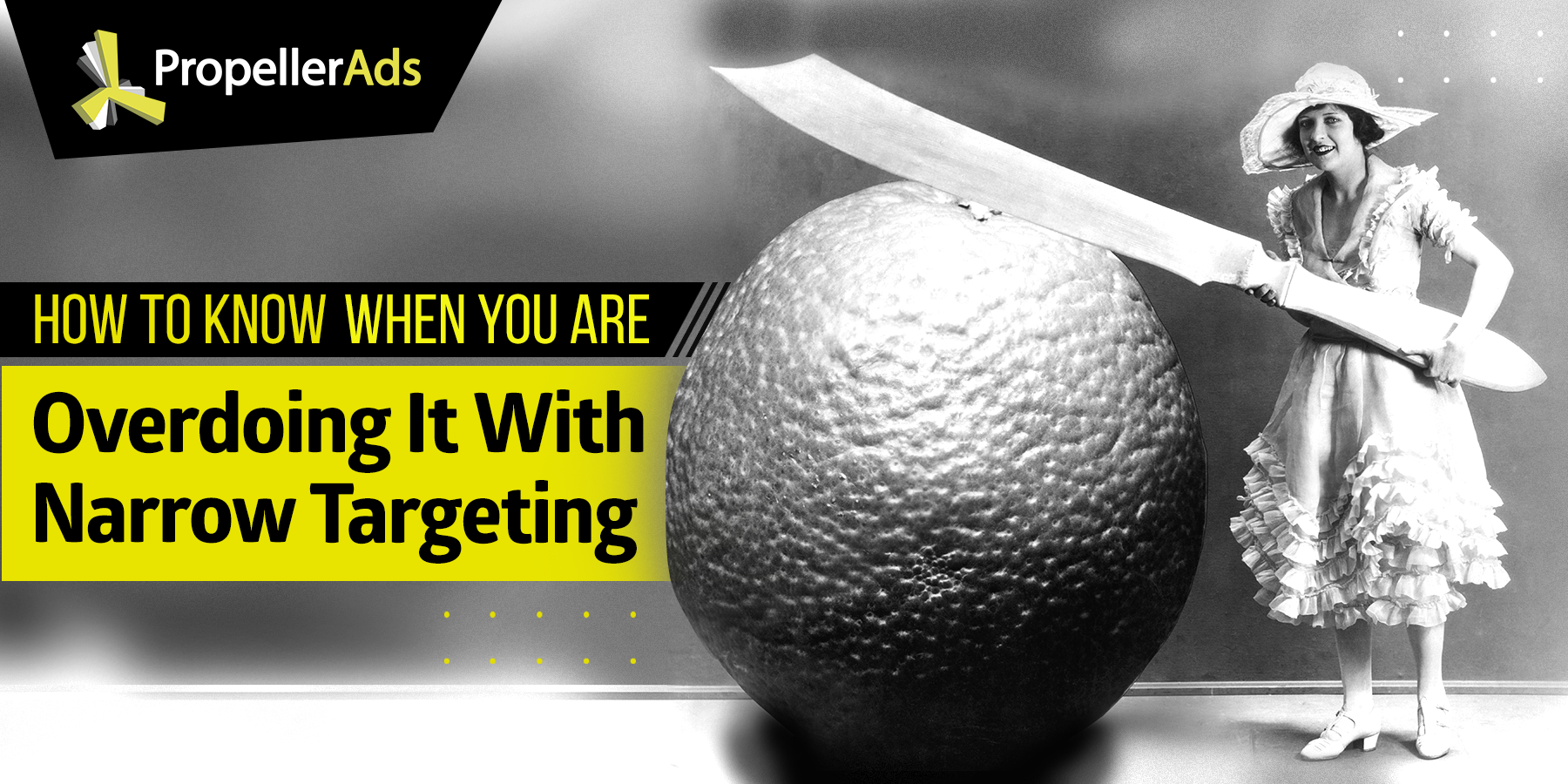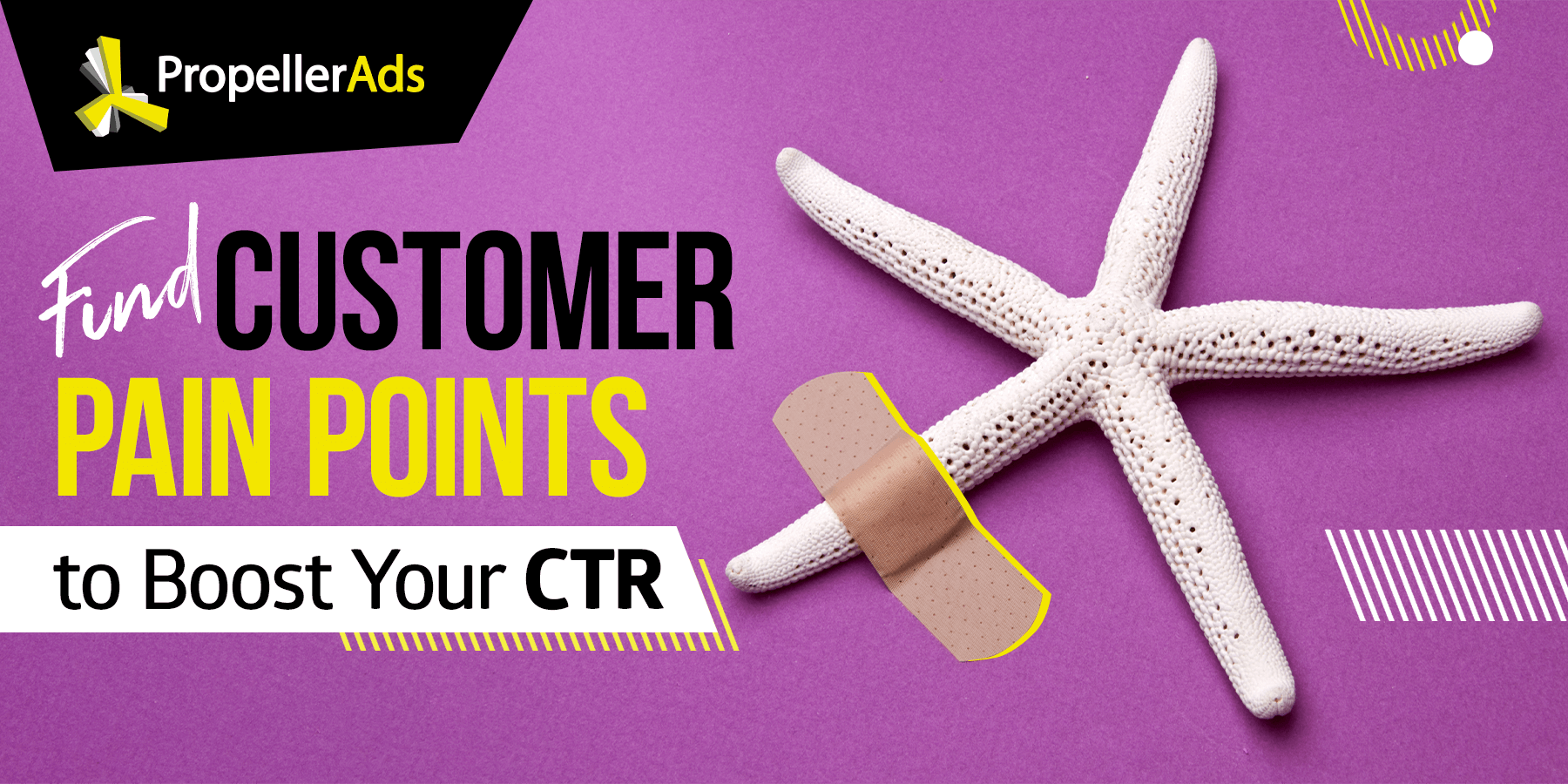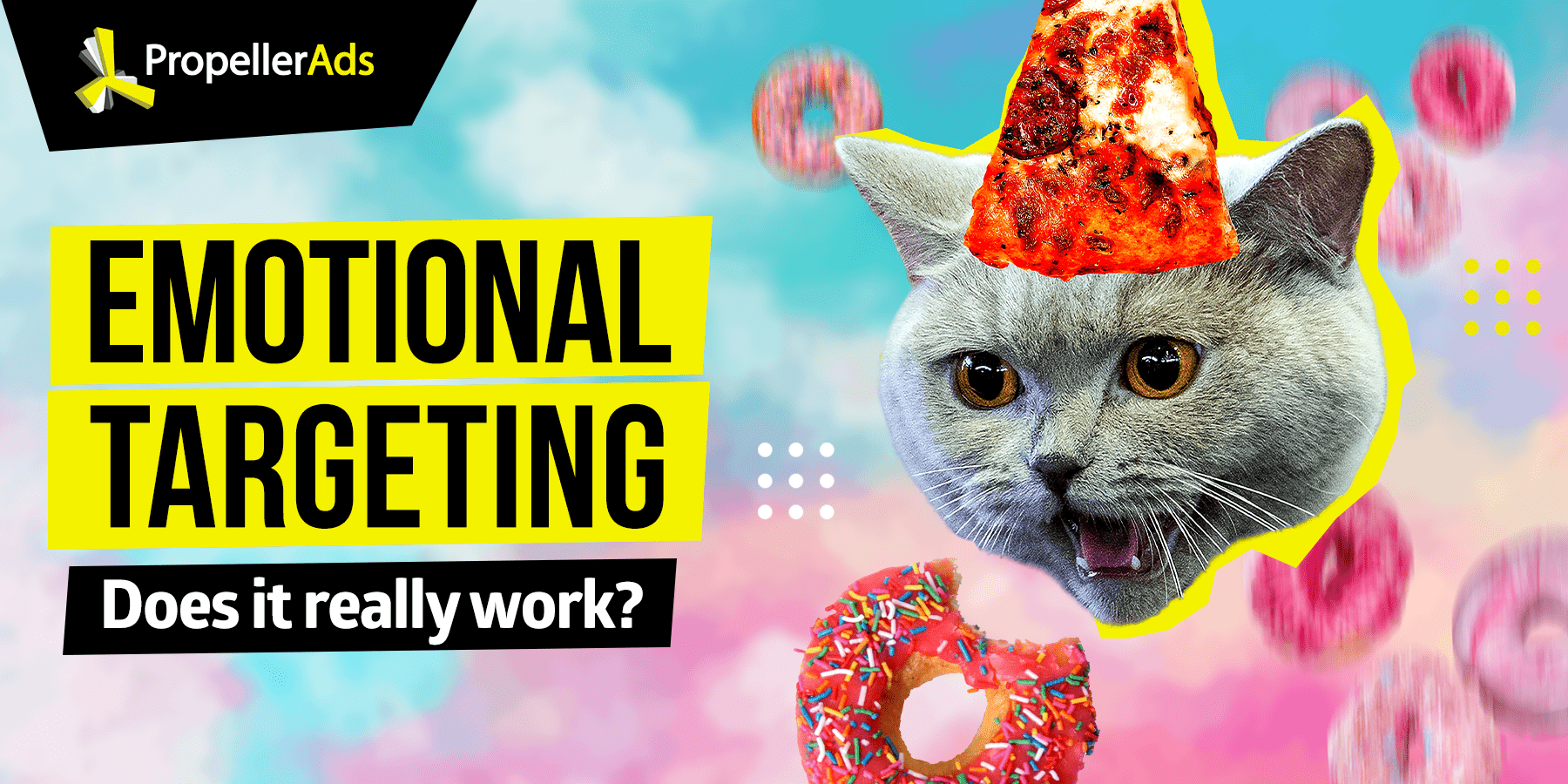The Key Elements of Ad Campaigns

This post is also available in:
PT
ES
Everybody thinks he’s an expert marketer, until it’s time to launch an effective Ad Campaign. But still, you’re in the marketing industry, so one way or another you must increase your Conversion Rate (CR) and aim for a higher Return on Investment (ROI).
In other words, you need to raise awareness about an offer, a product, or a service, draw people to interact with it, and ultimately convert, so that in return you get financial compensation (aka money?) – Your Goal.
How do you achieve it? You launch an Ad Campaign, that’s how! But when it comes to where do you get started, how, and what can you promote, well, that’s exactly what we’re going to see in this article.
So, in order to properly understand and plan the ad campaign, we’re going to explain which are the many elements that compose it, and just how you can increase your profits by effectively optimizing it.
#1. Targeting
This part allows you to narrow down on the slice of the audience that you want your ad campaign to reach, attract, and convert.
“When you choose the right audience, you attract relevant people and you will definitely see more conversions and a higher Click Through Rate (CTR).
Properly analyzing your target will help you gather all the useful metrics you need, to boost and optimize your campaign.
Audience targeting will also allow you to understand when and how exactly you should run your campaign.
Types of Targeting
With PropellerAds, you can target your audience based on the following aspects:
| • User Activity • Campaign Audience Reach • Countries (Cities, States) • Platform • OS • Device • Browser Language | • Connection Type • Daily and Total Budget • Mobile ISP • Zone Limitation • CPA Goal Value • Previously Collected Custom Audiences |
Targeting 101
1. Wide targeting: When you think about targeting, you should envision a funnel. You start from the wider part, and take it down from there. So, naturally, your first step should always be aimed at collecting as much data as you possibly can.
How can you do that? In affiliate marketing, your best shot, and most objective, is by testing. In order to achieve useful information, you should always test on wider slices of audiences.
Sure, the test period on wider audience slices, might take longer until you get the needed information. And with more time needed for testing, you might also need to allocate a larger budget. But this will get the job done.
Testing is the safest way to check ad placements, impressions, along with all the other data gathered. This way you can adjust and target smaller slices next.
2. Narrow targeting: Once you have gathered some data you can then narrow it down from there. For example, if you have noticed that a larger share of your audience is using Android devices, this might mean that you can expect a higher conversion rate when targeting Android users.
The next step might mean changing some other elements of your campaign, to see if you have any chance at reaching other OS users, or maybe giving those up, altogether.
Try to target ‘soon-to-be-interested’ users. However, if you’re going for results, you might have a better chance by slicing down on your audience and categorizing into smaller groups. Start by finding a common characteristic they share, and go from there.
Although, if your targeting is more narrow, consider that aside from the high CR, ROI, and cost-effective advertising for interested users only, you’ll probably get low traffic volumes, and insufficient data to properly optimize.
However, narrow targeting is more risky, and will likely perform poorly on long-term campaigns.
3. Time-frame targeting: You should also consider if the audience you’re targeting is more of a night owl, or an early bird? If this is the case, then you might want to identify the time frame when your audience is most active.
Do they have busy jobs? Then it might be best to run your campaigns in the morning, during lunchtime, and right before or after dinner. Based on the GEOs that will be included you need to keep in mind that these might vary.
For example: Dinner is served at 5 PM in the US. However this changes completely when you go to Italy, where dinner time is 8 PM. While Japan just decided to allocate some good 4 hours for dinner, between 6 and 10 PM.
Sure, you might easily find online which are the most convenient times of the day when to target your audiences. But when it comes to understanding their interests, likes, and dislikes, you’ll need some analytical skills. That, unless you’re not using our super user-friendly software.
And unless you’re not an advertising prodigy, with years of experience and a nose for crafting highly converting campaigns, you might want to steer clear of highly targeted or narrow campaigns.
4. Language Targeting: Another thing that you mustn’t forget, when it comes to defining your target, is the language that you’ll use, based on the GEOs that you’re planning on targeting.
Long story short, between the various important moments of the day, the language and other targeting criteria you should consider, your best chance at understanding the audience would be to conduct a thorough analysis of either:
- the audiences of similar campaigns that you’ve run
- your main competitors’ audiences
- or the audiences of all the other campaign elements that contribute to your overall CR (Bid, Creative Elements, Formats along with LPs and Pre-landers)
Tools You Can Use to Analyse Your Target
To make your life easier, savvy minds of the industry have invented various tools that will help you analyze, identify, and ultimately understand your target. Here’s to name a few:
#1. PropellerAds Traffic estimator & Stats (Advertising Platform) – Check the performance of all the available traffic for the chosen targeting settings, and access real-time, detailed statistics based on various performance metrics, and audience responsiveness from the moment you start running campaigns on our platform.
#2. Web Analytics (Google Analytics, SimilarWeb, Ahrefs, SEMRush, HotJar, Qualaroo, Optimizely, etc.)
#3. Comparative Analytics to check on your competitors (SimilarWeb, SEMRush)
#4. Social Media Analytics – if you’re running paid campaigns on any social media channel, you most likely receive various statistics
#5. Old-school Surveys – these are very interesting tools, which you can in fact turn into top-of-the-funnel, audience collecting campaigns. Forget modern technology, and actually turn to ask your audience what they like, and how they want it. You might be surprised.
However, the timing you’ll need to gather the data using this method will be exponentially higher than needed to use modern tools.
#2. Bidding or Pricing Models
If you want to make money, you must be willing to spend money. And that’s exactly what the Bid is – the amount of money you are willing to pay, for every click or thousand views that your ad gets.
However, the bid doesn’t guarantee that you will get all your conditions met, since – as the name suggests – you will participate in an auction to get an advertising spot for your ad.
One thing to consider when Bidding for ad placement is the fact that you only pay for the ads that users interact with. So, no interaction or impressions – no payment, even if you decide to pause your campaign.
The interaction is in fact, the action that your users need to complete so that you can get the conversion. And here are the popular Bidding Models you can choose from, when working with us:
| CPA Goal 2.0 Boosts your campaigns to reach your CPA Goal | CPM Cost Per Mile (1k impressions) | SmartCPM Optimized for the best CPM price/ad placement | CPC Cost Per Click | SmartCPC Optimized for the best CPC price/ad placement |
While with some bidding models you have better chances of winning the auction, there are also other factors that can determine whether or not you’ll get the spot for your ad:
-
Competitors – how many advertisers/affiliates are fighting for the same ad placement
-
Demand – how much interest the target has for the specific offer
-
Vertical – the niche or sector for which you’re advertising
-
Time frame – how active the audience is during this specific period
However, if you’re struggling with the bidding model, and are having a hard time finding the right value, you might want to try CPA Goal. It works by scooping for the best traffic, during the testing period, and it can bid really high for you to reach your target.
Knowing your target audience might be a very decisive factor in building your strategy, but also setting your bid and budget for the ad campaign. Just keep in mind that knowing how to properly set up a smart Bidding Strategy to successfully reach your goals, might be as important.
#3. Formats
The Marketing Formats are all the materials that you use to advertise your offer. The most popular ones are:
1. Push Notifications
More commonly known as Push, this is one of the most popular formats of the 21st century, so far. Push Notifications are the small alerts that appear on the screen of the device the user is operating from.
They’re highly reactive because of their native-alert look, and manage to almost always convince the user to take the needed action, as they’re gone forever, once closed.
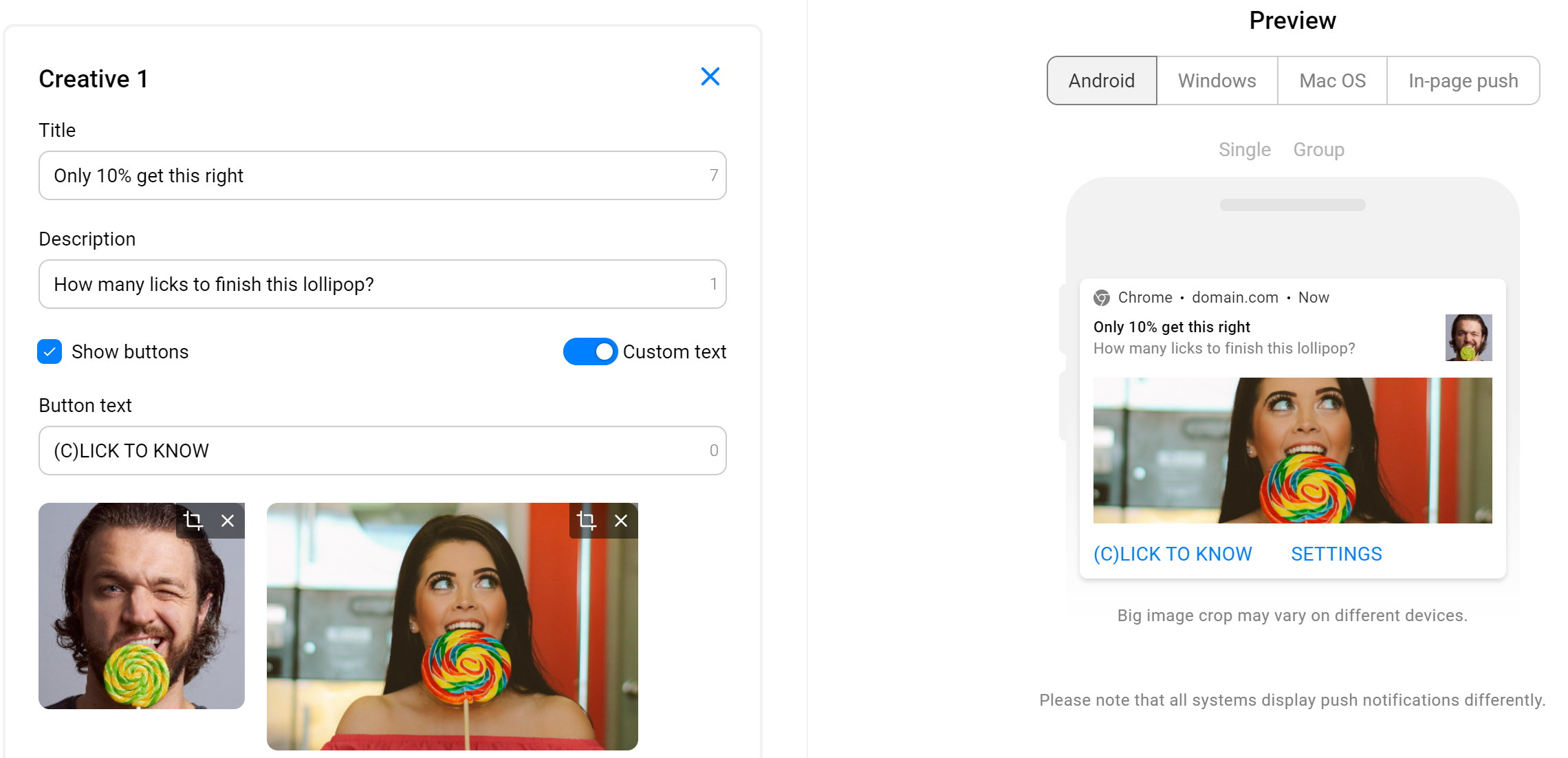
You can use 30 characters for the header, and 40 for the body (including emojis). In addition, Push Notifications also feature two different size images and a customizable Call To Action (CTA).
2. In-Page Push (IPP)
No matter the device type, you can send IPPs. You can send them on iOS as well, and even if users need to accept receiving them on a browser page, they also appear when the browser isn’t running.
A very nice feature of the In-Page Push Notification is the fact that you can set up various skins for it, to match every occasion.
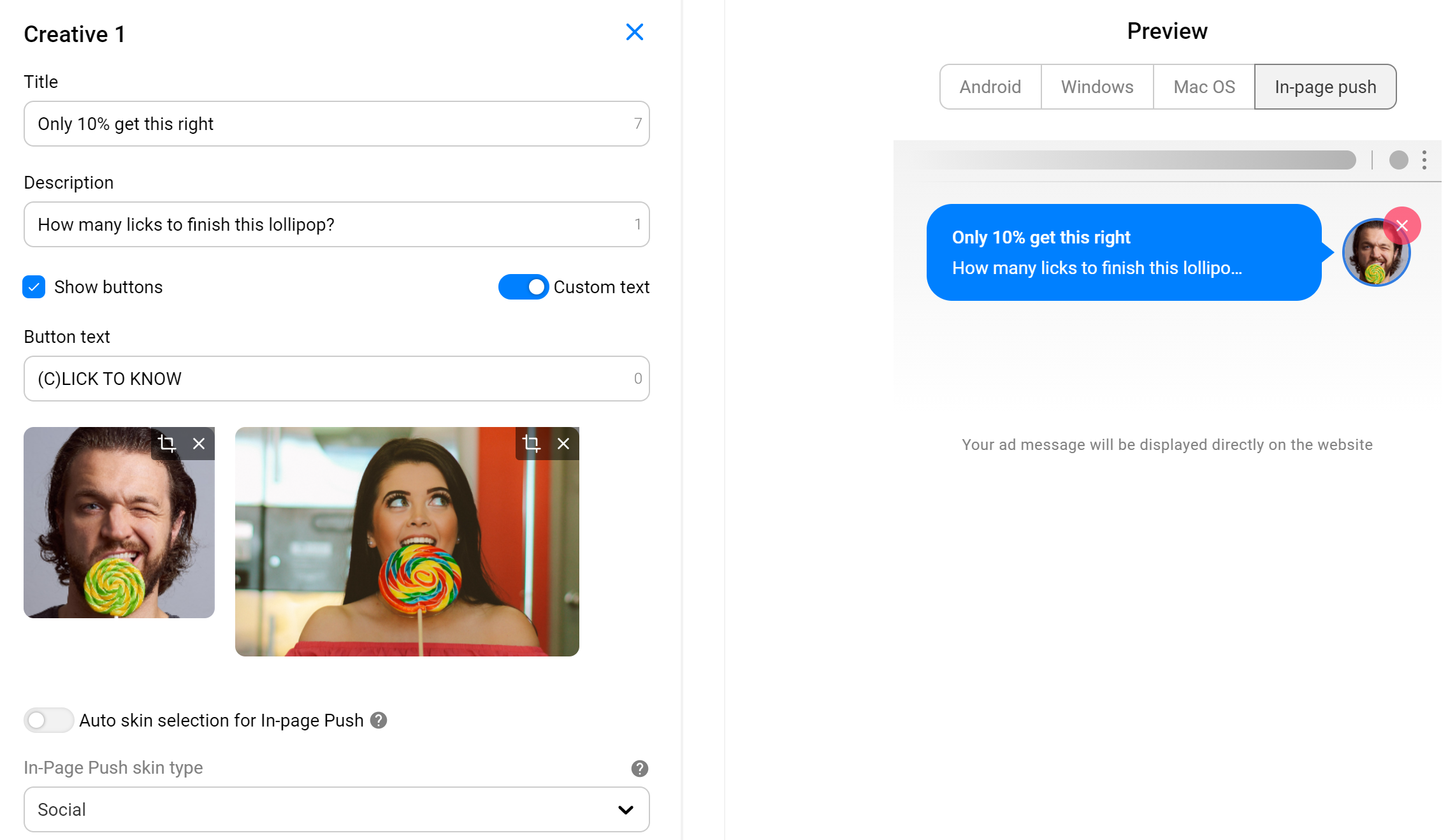
3. Interstitials
Larger formats can be set to cover the entire page or 2/3ds of it. Having more space for creative elements and text, this format can even be used to redirect the user straight to the website.
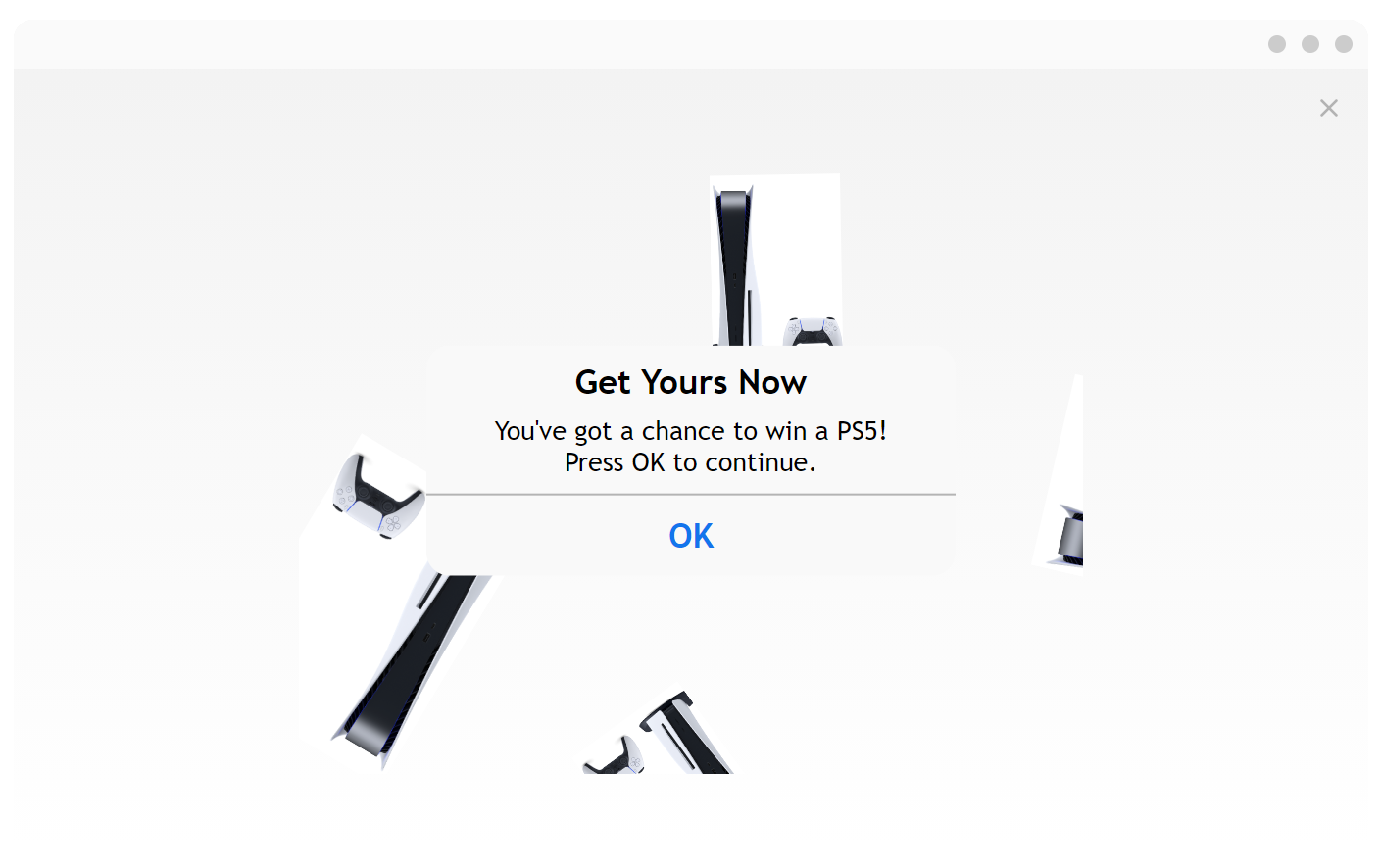
4. OnClick Popunder
This is a very versatile format that opens a new tab with your Landing Page or website once users click anywhere on the page where Popunders are set. It works fantastic on every vertical and is paired with any other format.
5. Survey Exit
This exclusive format, introduced by PropellerAds in 2023, allows you to attract the most engaged audience that visits your offer right after completing a survey on the same or similar topic.
The format offers additional targeting by a survey type: Finance, Giveaway, or Social. However, tests show that users greatly convert after passing through all kinds of surveys, so you get a very active and interested audience anyway.
#4. Creative Elements
The first thing you must do is to identify your audience, and then carefully analyze their pain points so that you build a solid creative strategy.
Remember that this part is about everything that has to do with the way that you transmit your message over to your audience. We’re talking about text and ad copy, colors, images, and CTAs. Basically, all the elements that will be found in your marketing collaterals, or formats.
When designing them, you need to consider a few things. For example, ask yourself: what kind of text and images will catch your target’s attention? Do you need to go more flashy-flashy, or will a more serious tone do it?
What about the images? If you read our India or MENA PDFs, you should know that there are some safety rules to follow, along with absolute NOs. And there are particular ones for every region or country.
Another factor you need to consider while designing your creatives is the Vertical for which you’re advertising. The reason why is because Verticals also dictate some guidelines that you should follow.
Here is the list of creative elements you can use at PropellerAds for various formats:
-
Custom Push buttons
-
Auto сreatives
#5. Landing Pages & Pre-landers
Once you finish defining and creating your formats, you need to link them to content specifically made to convince your audience to convert. Since often websites aren’t built to sell, and might be more informative, you can use Landing Pages and Pre-landers to cover this need.
Landing Pages are the largest marketing materials that you can possibly use. Here is where all the formats lead to.
When it comes to Landing Pages (LPs), you can forget about character restrictions, or limiting to the main ideas only. This is the format where you absolutely need to go big or go home. And keep in mind what is the purpose of this ad – to sell. So here is where you can use every card you have up your sleeve to convince your audience.
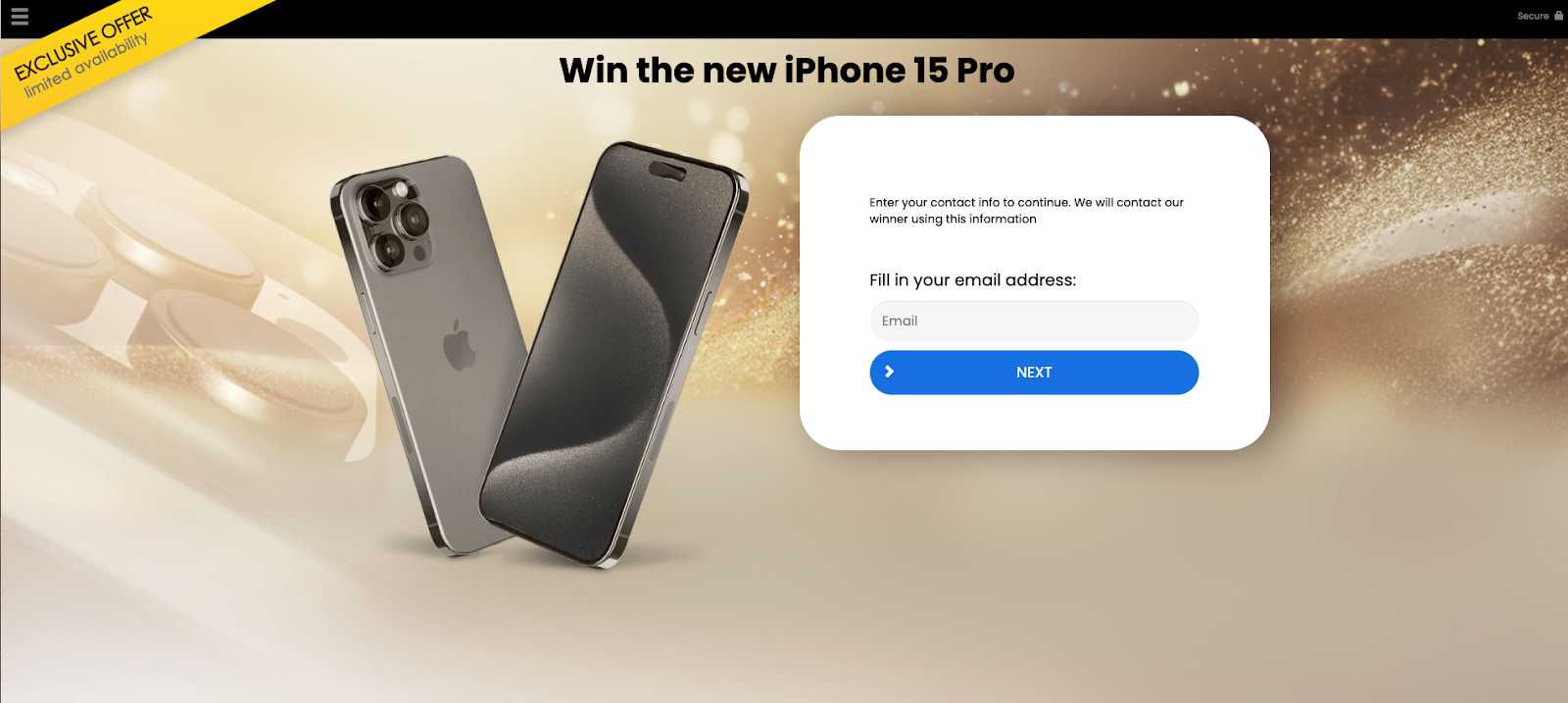
Write descriptive, life-long headers or as many paragraphs as you need, and illustrate it as you find more appropriate because LPs are all about details. This is the format where you want to give all the product information, the full, uncut version.
The user gets the entire info from your Landing Page, and from there he can navigate straight to the website and make the purchase or the action that you’re looking for.
Pre-landers
When you’re not ready to send the users straight to your Landing Page, you can use Pre-landers. These collaterals can warm up your audience by gently introducing the promotion you’re advertising on the Landing Page.
Pre-landers feature one or two paragraphs, aside from the header, CTA, and the images included. The purpose of Pre-landers is to tease the users and convince them to go to the Landing Page, where they’ll find more information.
Pre-landers can be connected either to the Landing Page, or straight to the Website. Moreover, they’re a great way for you to improve your Conversion and Click Through Rate (CTR), lower the bounce rates, or even identify areas of improvement.
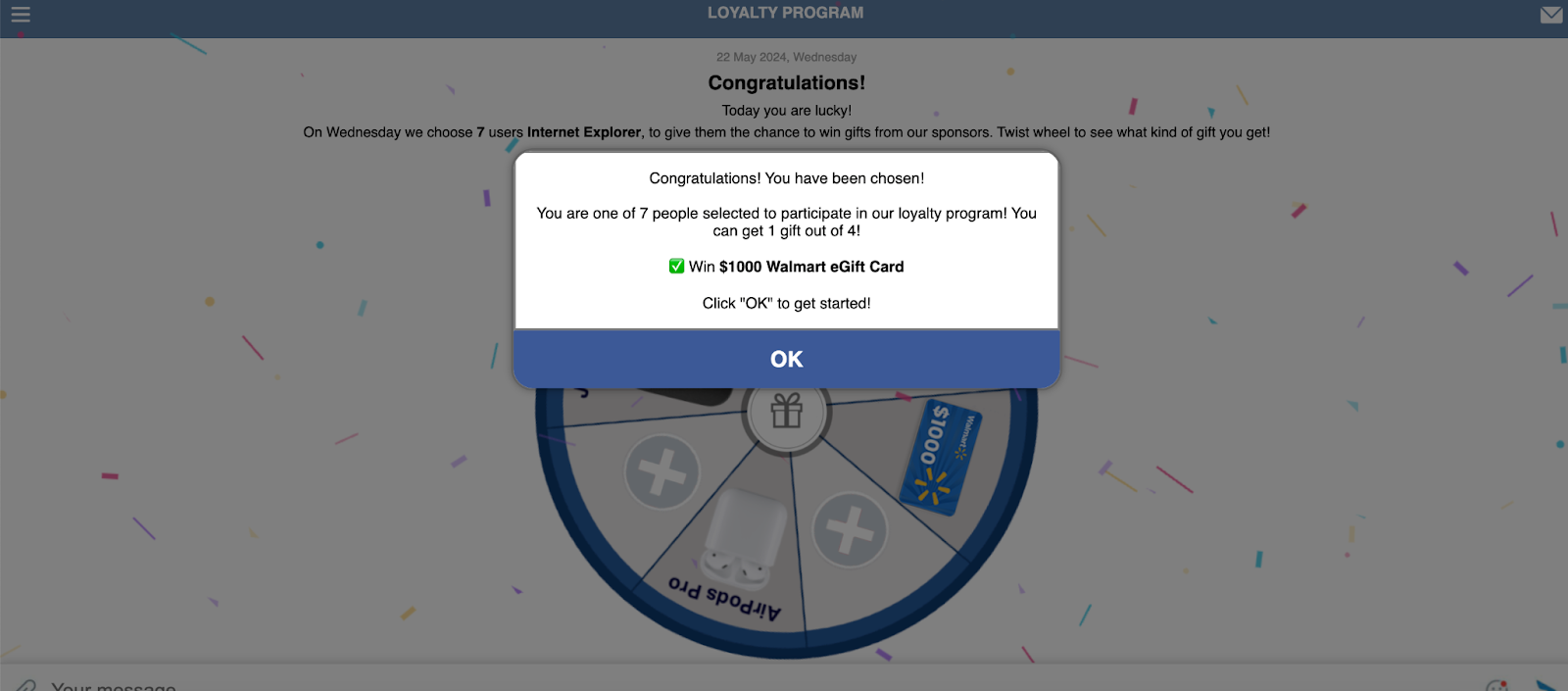
You need to consider these two marketing materials when you’re creating your Ad Campaign Strategy.
#6. CPA Offer
Lastly, when coming up with an Ad Campaign Strategy you should consider the Offer you’re advertising for. If you’re promoting various CPA Offers, you probably already know about its main elements.
If not, we’re talking about Vertical, Conversion Type, GEO, platforms, OS, and possible restrictions. Based on these, you need to adapt your creatives or even formats to match the Offer requirements. Otherwise, you might risk not getting paid.
Here is an example of a CPA offer:
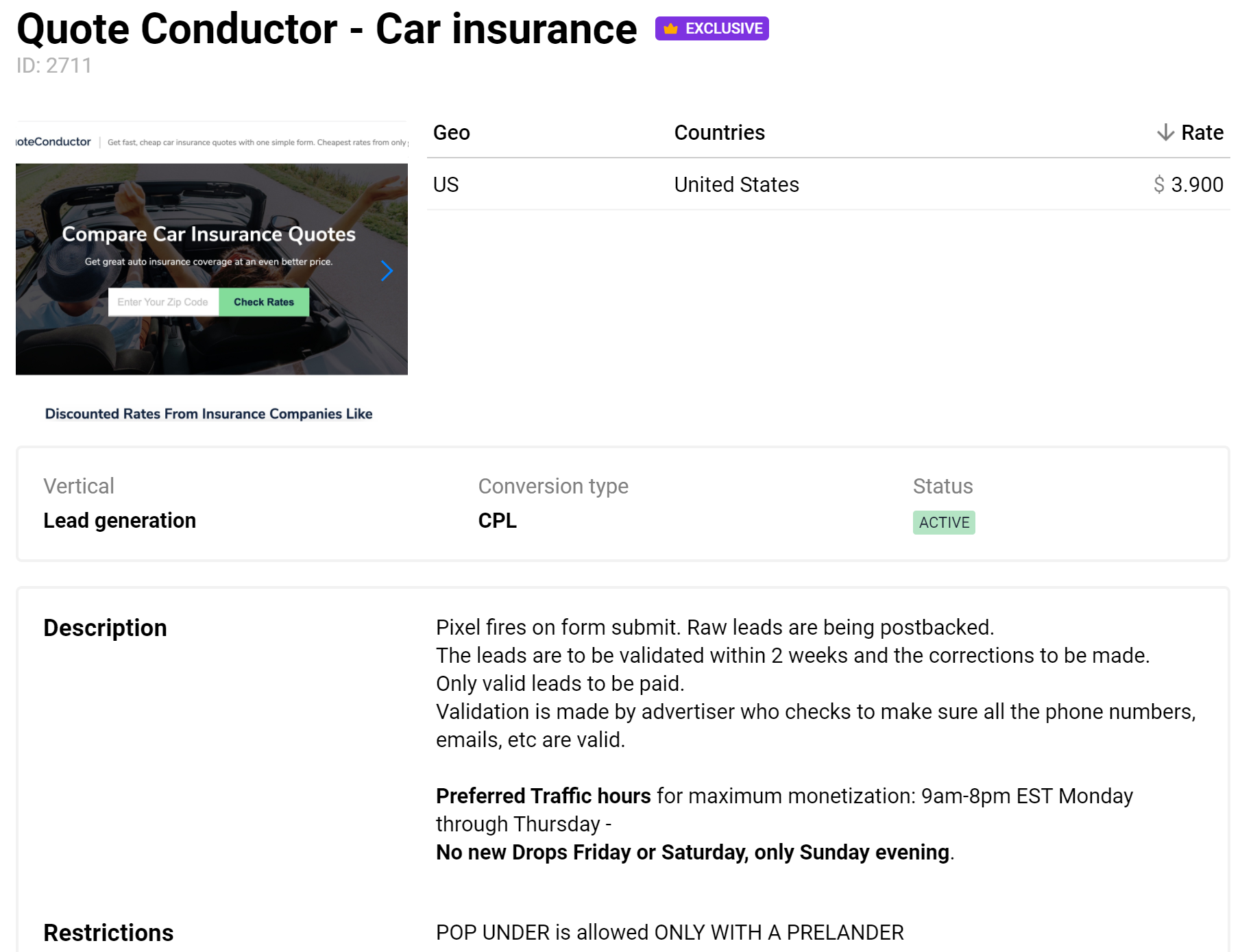
As you can see, the main elements of the CPA Offer happen to coincide with the key elements of the Ad Campaign. For this reason, when advertising for this kind of offer, you will only need to carefully research the Target in order to build your Ad Campaign Strategy.
Best Practices
| Targeting – Find out as many details you can, about your audience – Clearly define GEOs, platforms, OS, language – Go for wide targeting for big campaigns and large traffic volumes – Narrow targeting is for higher CR, ROI, and short campaigns – If you’re advertising CPA Offers, make sure to respect the Offer conditions | Bidding – Consider the traffic tiers: Tier 1– more expensive, Tier 3 – cheaper – Place your bids during the hours when your target is more active – Check your statistics and make sure to optimize your bids based on performance – Try to include one GEO per campaign, for better testing and optimization – Don’t forget to stay on top of your daily spend and allocate money accordingly |
| Formats – Your Push, IPP, and Interstitial content should match that of the Landing Page – Don’t spam your audience with too many ads – set the frequency based on their interest – Whenever it’s possible try to match the formats with the right vertical – Don’t forget about the platforms and OS requirements and optimize accordingly – Formats depend on your bidding model – Test each survey type of Survey Exit format in separate campaigns for better A/B test | Creative Elements – Make sure you use the language your audience understands – Always think about the CPA Offer requirements when designing creative elements – Don’t forget to make your images mobile-friendly – Adapt the tone and images to match your target audience preferences – ALWAYS A/B Test – You can choose auto creatives option if you don’t know what to add |
| Landing Pages & Pre-landers – Avoid mismatched messages – consistency is the key – A/B test to find the best placement for your CTAs – Break the Content with bullet points, lists, and images – Use eye-catchy images, but don’t overdo it – Try using Social Proof – embed tweets, or social media comments |
Want to talk to fellow affiliates? Join our BIG Telegram chat!
